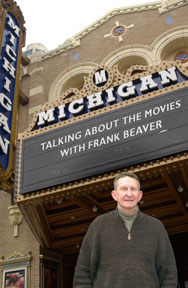
This web page is part of the Michigan Today Archive. To see this story in its original context, click here.
Talking About the MoviesWith Frank Beaver When Movies Hit the Road
By now most everyone knows that an unusually large number of critics thought Sideways to be the most interesting film of 2004, and thought so even after its one-Oscar take (Best Adapted Screenplay) at the Academy Awards. Filmgoers themselves have been so captivated by its wine-country sojourn that California wineries have been hard-pressed to meet demand for certain products touted by Sideways' characters. Tasting parties have been staged across the country with the movie's wines as honored guests. (This is not the first time a palate-related film concept has created such a cultural response; remember the Danish director Gabriel Axel's Babette's Feast of 1987?) I enjoyed the wine lessons provided by Sideways and now am aware of the social hazards of ordering a glass of Merlot when out with friends. But what I appreciated most about Sideways was its masterly use of the road picture concept.
Screenwriters have long explored the road picture because, first off, the idea of the road as a dramatic setting is innately cinematic. Alfred Hitchcock maintained that the cinematic theme par excellence was the chase, noting the motion picture's ability to move freely and rapidly through open spaces. North By Northwest (1959), Hitchcock's inimitable cross-country chase-thriller, gave evidence of his point. With its constantly changing geographic and social landscapes the road picture also lends itself to a perusal of contemporary life, and that is its special appeal for the provocative filmmaker: the road picture can exploit a seemingly casual, spontaneous dramatic incident for what might be described as a mobile slice-of-life. Screenwriters launch journeys of discovery with situations that impel characters to take to the road. Something has changed in their lives or is about to change, and moving away is the response. In Sideways it's an out-of-work actor who, along with his depressed, soon-to-be best man, is looking for a final fling before marriage. Their trip through California wine country turns into more than an oenophile's discourse on quality wines. In-car debates, spurred by the blatant sexual urges of the groom-to-be, call up the vagaries of male companionship. Happening upon two females along the way brings the men's very needy, disparate lives into sharper focus. In the end, Sideways provides, along with its many guffaws, a journey of self-discovery for the four principal characters, and poignant insights—some small, some large—for the filmgoer. Among the many other road pictures that have captivated me, I consider a half dozen or so as especially memorable. As a Vietnam-veteran graduate student in film at Michigan in the late 1960s, I was fascinated by the counter-culture movement that seemed to put young people and films into sync with one another.
In 1969's Easy Rider, two disaffected youth head out on their motorcycles in search of the "real America." The film's perusal of the country's cultural and political climates wasn't pretty, but its mythic imagery and dramatic road incidents struck a loud chord that resonated with viewers caught up in the political fervor of the time. In Harry and Tonto (Paul Mazursky, 1974), a recent widower (Art Carney) decides to leave the East Coast for a new life in California. Traveling by car with his cat, Tonto, Carney encounters people (a sexually forward female hitchhiker) and situations (a drop-in on a friend in a nursing home) that reveal issues of age and self-awareness. 1999's Straight Story, a road picture in which a 73-year-old Iowan drives his rider-lawn mower 300 miles to visit an ailing brother, was a charming variation on ageism issues touched on in Harry and Tonto. Who can forget Ridley Scott's Thelma and Louise (1991) with its wild car ride for two women in search of freedom and independence? The film still reverberates as a buddy road picture with women in the driver's seat. Of recent note are two delightful coming-of-age road pictures, the 2001 Alfonso Cuaron's Y Tu Mama Tambien (And Your Mama, Too) and 2004's The Motorcycle Diaries. In the former, two spirited young men travel across Mexico with an older woman; it's a journey mixed with self-doubt, sexual desire and a complexity of relationships. The Motorcycle Diaries by the Brazilian director Walter Salles, one of my favorite films of last year, recreates Che Guevara's year-long road adventure through Central America with a fellow medical school buddy. Based on Guevara's diaries and letters home, the film charts in the most endearing of ways Guevara's political awakening. For me, one of the powers of the road picture is its ability to capitalize on low-key, "found-story" styling for a dramatic experience that can be both charming and insightful.
|
|
Michigan Today News-e is a monthly electronic publication for alumni and friends. |
| MToday NewsE | |
|
|
Michigan Today
online alumni magazine
University Record
faculty & staff newspaper
MGoBlue
athletics
News Service
U-M news
Photo Services
U-M photography
University of Michigan
gateway



 Film historian and critic
Film historian and critic 